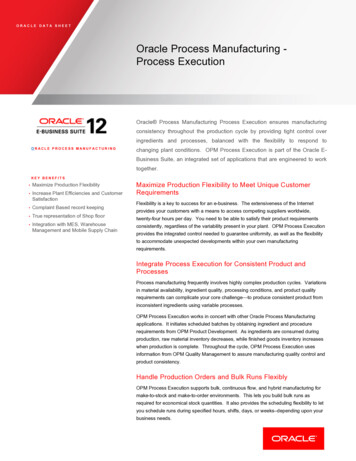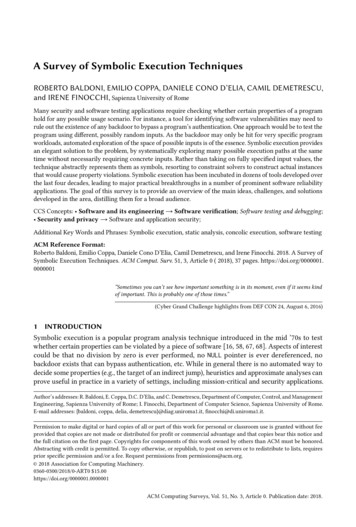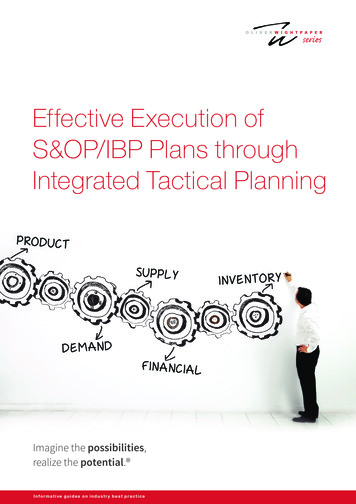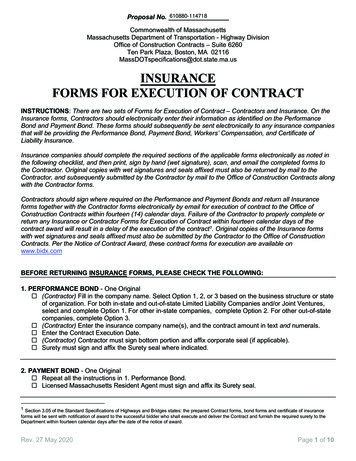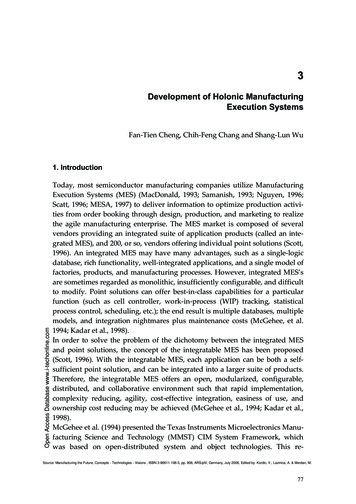
Transcription
3Development of Holonic ManufacturingExecution SystemsFan-Tien Cheng, Chih-Feng Chang and Shang-Lun WuOpen Access Database www.i-techonline.com1. IntroductionToday, most semiconductor manufacturing companies utilize ManufacturingExecution Systems (MES) (MacDonald, 1993; Samanish, 1993; Nguyen, 1996;Scatt, 1996; MESA, 1997) to deliver information to optimize production activities from order booking through design, production, and marketing to realizethe agile manufacturing enterprise. The MES market is composed of severalvendors providing an integrated suite of application products (called an integrated MES), and 200, or so, vendors offering individual point solutions (Scott,1996). An integrated MES may have many advantages, such as a single-logicdatabase, rich functionality, well-integrated applications, and a single model offactories, products, and manufacturing processes. However, integrated MES’sare sometimes regarded as monolithic, insufficiently configurable, and difficultto modify. Point solutions can offer best-in-class capabilities for a particularfunction (such as cell controller, work-in-process (WIP) tracking, statisticalprocess control, scheduling, etc.); the end result is multiple databases, multiplemodels, and integration nightmares plus maintenance costs (McGehee, et al.1994; Kadar et al., 1998).In order to solve the problem of the dichotomy between the integrated MESand point solutions, the concept of the integratable MES has been proposed(Scott, 1996). With the integratable MES, each application can be both a selfsufficient point solution, and can be integrated into a larger suite of products.Therefore, the integratable MES offers an open, modularized, configurable,distributed, and collaborative environment such that rapid implementation,complexity reducing, agility, cost-effective integration, easiness of use, andownership cost reducing may be achieved (McGehee et al., 1994; Kadar et al.,1998).McGehee et al. (1994) presented the Texas Instruments Microelectronics Manufacturing Science and Technology (MMST) CIM System Framework, whichwas based on open-distributed system and object technologies. This re-Source: Manufacturing the Future, Concepts - Technologies - Visions , ISBN 3-86611-198-3, pp. 908, ARS/plV, Germany, July 2006, Edited by: Kordic, V.; Lazinica, A. & Merdan, M.77
78Manufacturing the Future: Concepts, Technologies & Visionsengineering effort used the OMT methodology models (Rumbaugh et al., 1991)to express the MMST Framework. Following the MMST CIM System Framework, SEMATECH developed the CIM Framework Specification version 2.0(SEMATECH, 1998), which is an abstract model for typical semiconductormanufacturing systems.Several approaches to distributed manufacturing architectures were surveyedby Kadar et al. (1998), and their fundamental features were highlighted. Moreover, an object-oriented simulation framework for development and evaluation of multi-agent manufacturing architectures was introduced by Kadar et al.(1998). Further, Cheng, et al. (1999) applied the distributed object-orientedtechnologies to develop the MES Framework. This framework has the characteristics of openness, modularization, distribution, reconfigurability, interoperability, and easy maintenance.Common automatic manufacturing systems have fragility and security problems that also need to be seriously taken into consideration, however these twoissues are not considered in the MES frameworks mentioned above. This paperapplies the concepts of holon and holarchy to redesign a Holonic Manufacturing Execution System (HMES) Holarchy that not only possesses the characteristics of the MES Framework (Cheng et al., 1999) but also has the properties offailure recovery and security certification.The concepts of holon and holarchy are originated from mechanisms of socialorganizations and biological organisms (Valckenaers et al., 1994; Tonshoff etal., 1994; HMS; Van Leeuwen & Norrie, 1997). They have the characteristics ofintelligence, autonomy, coordination, reconfigurability and extensibility. Basedon these characteristics, the major weakness in the automatic manufacturingsystems, fragility, is removed so that the failure recovery feature is attained.Security certification also can be considered.A typical deployment diagram for HMES in the semiconductor packagingplant is displayed in Fig. 1. HMES includes Shop-Floor Holon, SchedulingHolon, WIP Holon, Data Warehouse, Material Handling, Equipment Holon,Equipment, AGV, AS/RS and so on. The HMES Holarchy will be developed bya systematic approach in this paper. For demonstration purpose, one of thefunctional holons - WIP Holon - will be designed and implemented. Most ofthe studies concerning holonic manufacturing systems (Markus et al., 1996;Ramos, 1996; Hino & Moriwaki, 1999) focus on factory architecture and/orhow to assign a production task to each manufacturing holon. The purpose ofthis paper is to propose a systematic approach for developing a workable
Development of Holonic Manufacturing Execution Systems79Holonic Manufacturing Execution System (HMES) by applying up-to-datesoftware and information technologies. The systematic approach is startedwith system analysis by collecting domain requirements and analyzing domain HolonRobotAS/RSAGVFigure 1. Deployment Diagram for Holonic Manufacturing Execution SystemsThe HMES Holarchy is designed by the procedure of constructing an abstractobject model based on domain knowledge, partitioning the application domain into components, identifying generic parts among components to formthe Generic Holon, developing the Generic Holon, defining holarchy messagesand the holarchy framework of HMES, and finally designing functional holonsbased on the Generic Holon. The technologies (Chen & Chen, 1994; Gamma etal., 1995; Mowbray, 1995; Orfali et al., 1996; Sparks et al., 1996) of distributedobject-oriented approach, design pattern, framework, N-tier client/server architecture, and component software are applied to develop the entire HMESand its functional holons.This paper is organized as follows: Section 2 introduces the characteristics ofholon and holarchy. Section 3 describes the development procedure of HMES.This development procedure includes four stages: system analysis, holarchydesign, application construction, and system integration and testing. Amongthose stages, holarchy design needs most elaboration and it is explained in de-
80Manufacturing the Future: Concepts, Technologies & Visionstail in Section 4. Section 5 demonstrates WIP holon design. Section 6 describesapplication construction and system integration. Section 7 makes comparisonsamong Legacy MES, Framework MES, and Holonic MES. Finally, this paperends with summary and conclusions.2. Characteristics of Holon and HolarchyTwenty-six years ago, the Hungarian author and philosopher Arthur oestlerproposed the word holon to describe a basic unit of organization in biologicaland social systems. A holon, as Koestler devised the term, is an identifiablepart of a system that has a unique identity, yet is made up of sub-ordinateparts and in turn is a part of a larger whole.The strength of holonic organization, or holarchy, is that it enables the construction of very complex systems that are nonetheless efficient in the use ofresources, highly resilient to disturbances (both internal and external), andadaptable to changes in the environment in which they exist. All these characteristics can be observed in biological and social systems.The stability of holons and holarchies stems from holons being self-reliantunits, which have a degree of independence and handle circumstances andproblems on their particular level of existence without asking higher levelholons for assistance. Holons can also receive instruction from and, to a certainextent, be controlled by higher-level holons. The self-reliant characteristic ensures that holons are stable and able to survive disturbances. The subordination to higher-level holons ensures the effective operation of the larger whole.The task of the Holonic Manufacturing System (HMS) consortium is to translate the concepts that Koestler developed for social organizations and livingorganisms into a set of appropriate concepts for manufacturing industries. Thegoal of this work is to attain in manufacturing the benefits that holonic organization provides to living organisms and societies, e.g., stability in the face ofdisturbances, adaptability, and flexibility in the face of change, and efficientuse of available resources.As an initial step, the HMS consortium developed the following list of definitions (among others) to help understand and guide the translation of holonicconcepts into a manufacturing setting (Van Leeuwen & Norrie, 1997; Ulieru,1997):a) Holon: An autonomous and cooperative building block of a manufacturing system for transforming, transporting, storing and/or validating in-
Development of Holonic Manufacturing Execution Systems81formation and physical objects. The holon consists of an information processing part and often a physical processing part. A holon can be part ofanother holon.b) Autonomy: The capability of an entity to create and control the executionof its own plans and/or strategies.c) Cooperation: A process whereby a set of entities develops mutually acceptable plans and executes these plans.d) Holarchy: A system of holons that can cooperate to achieve a goal or objective. The holarchy defines the basic rules for cooperation of the holonsand thereby limits their autonomy.e) Holonic Manufacturing System (HMS): A holarchy that integrates theentire range of manufacturing activities from order booking through design, production, and marketing to realize the agile manufacturing enterprise.f) Holonic Attributes: The attributes of an entity that make it a holon. Theminimum set is autonomy and cooperatives.Based on the above definitions, it is clear that holonic manufacturing systemscan be regarded as a unified way to approach the hierarchical control of anymanufacturing unit from the production process to the whole enterprise level.In this work, the concepts of holon and holarchy are adopted to develop theHMES Holarchy so that the functional holons of the HMES can possess theproperties of intelligence, autonomy, cooperation, reconfigurability, and extensibility. In addition, the functional holons of the HMES Holarchy can havethe capabilities of failure recovery and security certification.3. Development Procedure of Holonic Manufacturing Execution SystemsAs depicted in Fig. 2, the development procedure of HMES includes fourstages: (a) system analysis, (b) holarchy design, (c) application constructionand (d) system integration and testing. Note that the final step of holarchy design stage is functional holon design and implementation.The first stage, system analysis, concentrates on collecting domain requirements and analyzing domain knowledge. The second stage, the most important stage, is holarchy design, which is further divided into seven steps asshown in Fig. 2.
Manufacturing the Future: Concepts, Technologies & Visions82Collect Domain RequirementsSystem AnalysisAnalyze Domain KnowledgeModifyConstruct Abstract Object ModelPartition Application Domain intoComponentsIdentify Generic Functions amongComponentsDevelop Generic HolonHolarchy DesignDefine Holarchy MessagesModifyDefine Holarchy Framework ofHMESDesign Functional Holons Based onGeneric HolonFunctional Holons' Design and ImplementationConstruct ApplicationsApplication ConstructionIntegrate System and Test ItSystem Integration and TestingFigure 2. Development Procedure of Holonic Manufacturing Execution SystemsThe system’s object model is constructed according to the domain knowledgeand requirements. The application domain is partitioned into components thatwill eventually become various functional holons. Within these components,their generic functions are further identified and extracted. Based on these generic functions, the so-called Generic Holon is developed. Holarchy messagesamong functional holons are defined and holarchy framework of HMES (alsodenoted HMES Holarchy) is developed. Finally, various functional holons canbe designed by inheriting the Generic Holon and implementing the holarchymessages. The third stage of HMES development is application construction.Finally, the development procedure ends with system integration and testing.4. Holarchy DesignSeven steps are included in the holarchy design stage. They are explained below.
Development of Holonic Manufacturing Execution Systems834.1 Constructing an Abstract Object ModelA typical deployment diagram for HMES is shown in Fig. 1. It is well knownthat MES is composed of several functional modules that handle specifics, e.g.material, equipment, labor, and planning (MacDonald, 1993). The abstract object model is constructed as in Fig. 3(a) (Cheng et al., 1999).The four key elements of a factory are labor, material, equipment, and workin-process (WIP). Each element is managed by its specific managing holon. Allfour of these managing holons are controlled by the Shop-Floor Holon. TheShop-Floor Holon also dispatches orders to the Scheduling Holon. The Scheduling Holon dispatches jobs to the Labor Holon, Material Holon, EquipmentHolon, and WIP Holon.4.2 Partitioning Application Domain into ComponentsTo design a distributed and integratable MES, its application domain is partitioned systematically as depicted in Fig. 3(b). In addition to the data warehouse, the system is divided into six components.DataWarehouseFactoryArea*Material0 *0 *LaborHolonManagesLabor*0 *MaterialHolon0 *0 *Equipment0 *WIP0 *0 *EquipmentHolonSupport all objects toaccess data0 *Manages*Manages0 0 Manages0 0 *Controls0 *WIPHolon0 Shop-FloorHolonDispatchesorders0 **Dispatches jobsSchedulingHolon(a) Abstract Object ModelThey are labor management, material management, equipment management,WIP management, scheduling, and shop-floor management components. The
Manufacturing the Future: Concepts, Technologies & Visions84labor, material, equipment, and WIP management components handle labor,movements of materials, process equipment, and WIP tracking, respectively.The scheduling component takes care of scheduling and dispatching tasks ofthe system. The shop-floor management component is in charge of systemlevel services and management, i.e., order management, life-cycle services, collection services, and query services. Each management component has a specific functional holon, which serves as the manager of that specific management componentDataWarehouseFactoryAreaLaborMaterial0. *MaterialManagementComponent0. *0. *ManagesManages0. *LaborManagementComponentLaborHolon0. *0. *EquipmentEquipment 0. *ManagementComponent0. *MaterialHolon0. *WIP0. *WIPManagementComponent0. *EquipmentHolon0. *Manages0. *Manages0. *Support all objectstoaccess rHolon0. *DispatchesordersWIPHolon0.*Dispatches jobsSchedulingHolonScheduling Component(b) Partitioning Application Domain into ComponentsFigure 3. Object Model of an HMESAs mentioned previously, each management component needs a specific functional holon to serve as the manager of that component.4.3 Identifying Generic Functions among ComponentsThe purpose of this paper is to apply the concepts of holon and holarchy to design the HMES Holarchy and functional holons that not only possesses theproperties of the MES Framework (Cheng et al., 1999) but also has the properties of failure recovery and security certification. Therefore, based on the prin-
Development of Holonic Manufacturing Execution Systems85ciple of software reuse (Chen and Chen, 1994; Cheng et al., 1999), the GenericHolon which handles the generic functions of functional holons shall first bedevised. After judicious consideration, the authors conclude that in addition tothe communication infrastructure, the Generic Holon shall possess securitymechanisms, search mechanisms, and intelligence mechanisms to deal withthe generic functions that emphasize failure recovery and security certification.4.4 Developing Generic HolonThe requirements for developing the Generic Holon are:a) It can construct the communication infrastructure for communication,collaboration, and extensibility purposes.b) It provides the intelligence mechanism for exception diagnosis.c) It provides the search mechanism for collaboration and reconfigurability.d) It provides the security mechanism for security check and encryption /decryption.e) It provides the ability to establish database services for information storage / retrieval.According to these requirements and following the development procedurefor object-oriented systems (Eriksson and Penker, 1998; Huang et al., 1999;Cheng et al., 2002), the Generic Holon’s class diagram and internal architectureis obtained as shown in Fig. 4. For further illustration, please refer to (Lin,2000; Chang, 2000) for the detailed designs of the Generic Holon.Observing Fig. 4(a), the basic structure of the class diagram is HolonKernelmanages/uses HolonConfiguration that consists of CORBAInterface, SecurityMechanism, LocalDatabase, and KnowledgeBase. By inheriting HolonKernel, a functional holon can possess all the characteristics of the Generic Holon.CORBAInterface is designed for constructing a communication infrastructureand achieves the collaboration platform. In order to establish secure communication, the SecurityMechanism is created for handling all the operations of security. KnowledgeBase constructs a search engine for searching desired services and a reasoning mechanism for exception diagnosis. The LocalDatabasesets the connection of database for SecurityMechanism and KnowledgeBase toaccess the database. On the other hand, the internal architecture of the GenericHolon is depicted in Fig. 4(b).
Manufacturing the Future: Concepts, Technologies & Visions86Holon ()Diagnose()AddRule()Match()RuleFilter()(a) Class HolonKernelCORBAInterface(b) Internal ArchitectureFigure 4. Class Diagram and Internal Architecture of Generic HolonObserving Fig. 4(b), the Generic Holon owns HolonKernel to communicatewith other holons by CORBAInterface. Using LocalDatabase, the GenericHolon can maintain autonomous properties and necessary information. SecurityMechanism can retrieve the related information through LocalDatabase andthen check user’s authorization for security certification. The intelligence
Development of Holonic Manufacturing Execution Systems87mechanism for exception diagnosis purposes of the Generic Holon is mainlyconsidered in knowledgeBase that also needs the support of LocalDatabase.After completing the design of the Generic Holon, any functional holon can bedesigned by inheriting Generic Holon to obtain generic properties of holonand then adding the specific functions of that functional holon.4.5 Defining Holarchy MessagesAfter partitioning the application domain into components, we need to defineholarchy messages among all the functional holons so that interoperability andcollaboration among all the functional holons are enabled. According to Fig. 1and Fig. 3(b), the holarchy messages of HMES are defined as in Fig. 5.Move lot to AGVOrder doneMaterial HandlingAS/RSGet item master , BOMWIP HolonSave order informationGet item master ,equipment status, andorder statusUpdate lot statusData WarehouseFigure 5. Defining Holarchy MessagesRobot Track in
Data Warehouse Robot AGV Shop-Floor Holon WIP Holon Scheduling Holon Material Handling Equipment Holon Equipment Holon Figure 1. Deployment Diagram for Holonic Manufacturing Execution Systems The HMES Holarchy is designed by the procedure of constructing an abstract object model ba
